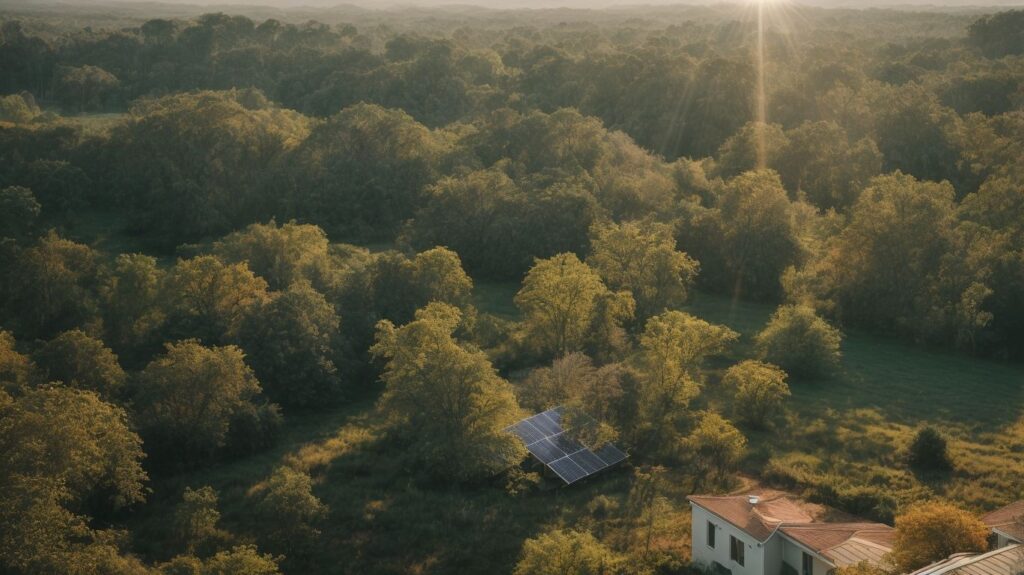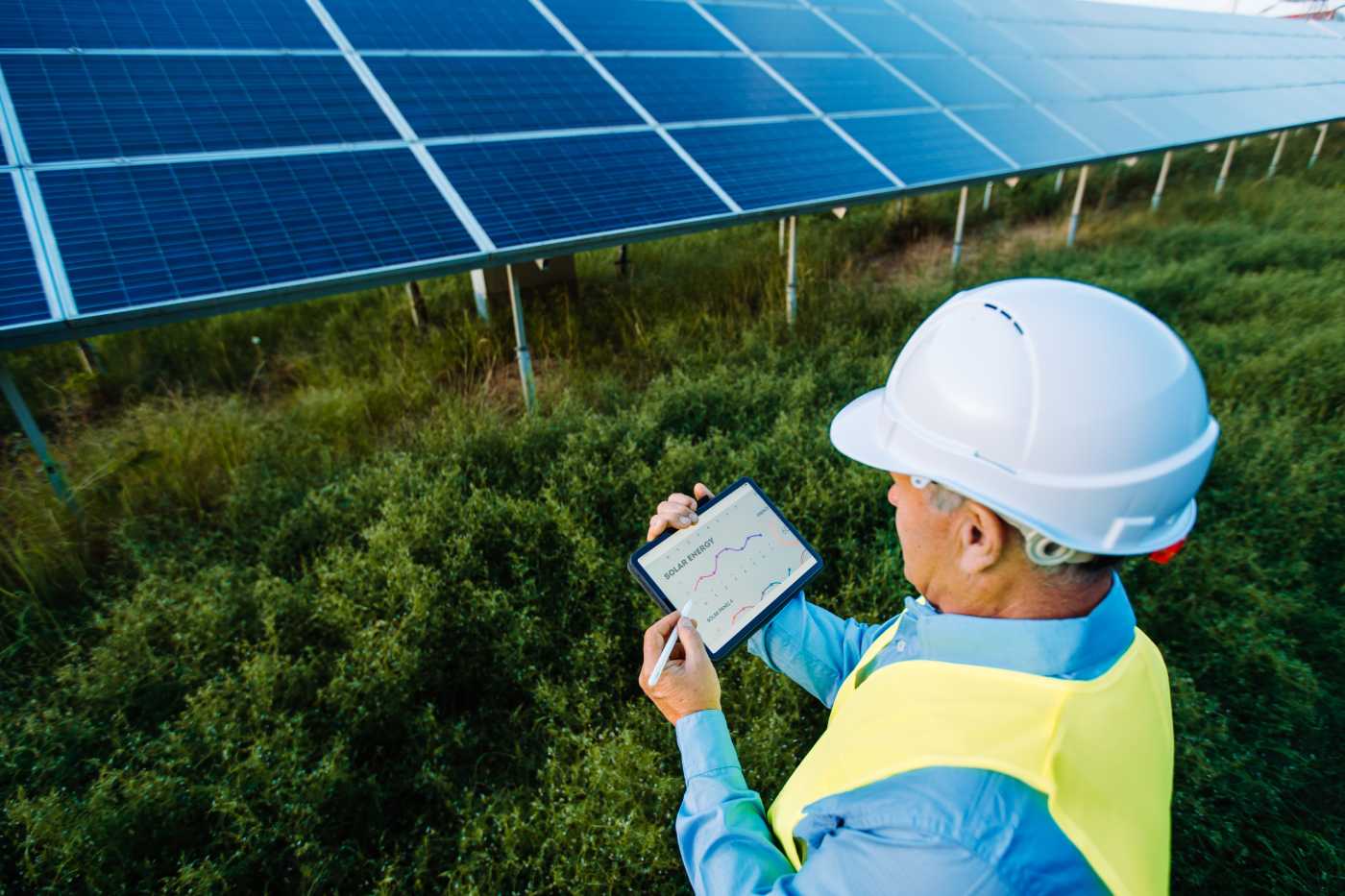We start our journey into the world of solar panels by looking at the crucial factor of solar panel angle. This plays an important role in getting the most energy from the sun. By understanding and setting the right angle, we can make solar panels work to their fullest.
The angle affects how much sun the solar panels get. This directly affects the amount of electricity they can make. A correct angle lets solar panels capture the right amount of sunlight. It’s amazing how a small change can have a huge effect on the production of renewable energy.
Another thing to remember is that the ideal angle depends on where the solar panels are. The latitude of a place affects what angle the panels should be at for the best results. Looking at seasonal changes, climate, and energy needs can help experts find the best angle for each area.
Research from the National Renewable Energy Laboratory (NREL) shows that changing the angle of solar panels during the year can increase energy production by 5-20%. This shows how important it is to keep an eye on solar panel angles and adjust them to get the most out of renewable energy.
Table of Contents
ToggleUnderstanding the importance of solar panel angle
The angle of solar panels is very important for their efficiency and performance. Realizing this is vital for maximizing energy output and getting the best return on investment.
Angling them towards the sun lets them receive direct sunlight for longer, leading to more electricity production. This is especially important in places with less sunlight or during winter, when the sun’s angle is lower.
The angle also helps panels self-clean. When they are tilted at the right angle, rainwater removes dust and dirt. This keeps the panels working well, and reduces the need for manual cleaning.
Experts should be consulted to decide the ideal tilt and orientation.
This depends on the geographical location, climate, and energy needs.
Adjustable mounting systems can be used to adjust the panel angles according to the sun’s position. This ensures optimal energy production throughout the year.
Technology can be used to monitor weather patterns and panel performance. Data-driven decisions about adjusting angles based on prevailing weather can make sure energy output is consistent.
Factors to consider when determining the optimal solar panel angle
Determining the best solar panel angle is essential to get the most energy. Many things need to be taken into account, like:
- Geographic Location – The angle should change based on the latitude for maximum sunlight all year-round.
- Tilt Angle – A fixed or adjustable tilt system can be chosen based on location.
- Seasonal Variations – Think about the sun’s position throughout the year.
- Shading – Buildings, trees, or other things that could cast shadows.
- Roof Orientation – Which direction your roof faces relative to south.
Technology advancements in solar panel design and tracking systems make it possible to adjust the angles automatically for efficiency. For instance, one homeowner in a suburb set up their panels with an optimal tilt angle. But, when the seasons changed, trees started casting shadows. So, they got a tracking system to adjust the panel angles throughout the day based on sunlight availability. This small change led to a major increase in energy production.
Considering all these factors when picking the best solar panel angle will give you the best energy output. Analyzing your situation and getting advice from experts helps you make the best decision and get the most out of solar energy.
How to calculate the ideal solar panel angle
Calculating the perfect solar panel angle can seem complex, but it’s possible with the right guidance. Here’s a 3-step guide to find the optimal angle for your panels.
- Consider your location: First, think about your geographical position. Sunlight varies depending on your latitude. Generally, the nearer you are to the equator, the more direct sunlight you will get. Take note of your coordinates or location and move on to the next step.
- Work out the tilt angle: Now that you have your location info, figure out the tilt angle for your solar panels. As a guideline, for fixed solar panels, set the tilt angle equal to your latitude. E.g. if you’re at 40 degrees latitude, your panels should be tilted 40 degrees from horizontal.
- Adjust for the seasons: While setting the panels at your latitude is a great starting point, it won’t always get the best performance. To get the most energy all year round, experts suggest adjusting the angle for the different seasons. For winter months, tilt them steeper (around 15 degrees more than your latitude). For summer months, reduce the tilt angle (around 15 degrees less than your latitude).
Taking these factors into account will help you find the ideal solar panel angle for your location and time of year. Don’t miss out! Use these tips to get the most out of your clean energy investment!
Adjusting the solar panel angle
For top efficiency, adjusting solar panel angles is key. Aligning them right ensures optimal sunlight absorption and more energy output. Here’s a 6-step guide to help you adjust your solar panel angle:
| 1. Evaluate location: | Know your geographical position and sunlight exposure throughout the year before adjusting the angle. |
| 2. Calculate tilt angle: | The ideal tilt angle changes with latitude. Use online calculators or ask experts for the recommended tilt. |
| 3. Adjust in spring & fall: | For fixed-tilt systems, set the angle near the latitude value when the sun is lower in the sky. |
| 4. Optimize for winter: | In winter, tilt your solar panels at an angle equal to your latitude plus 15 degrees for max sunlight. |
| 5. Optimize for summer: | In summer, decrease the tilt angle by 15 degrees from your latitude for better performance in high sun conditions. |
| 6. Monitor & fine-tune: | Keep an eye on energy production & make small adjustments if needed based on performance data. |
Plus, invest in adjustable mounts, clean regularly, trim surrounding vegetation, & consider seasonal tracking for higher energy yield. With these guidelines & suggestions, you can make the most of your solar investment.
Tips for maximizing solar panel angle efficiency
Maximizing solar panel angle efficiency is essential for getting the most energy production. Here are 4 tips to make sure of it:
- Orientation: Put your solar panels so they face south (in the northern hemisphere) or north (in the southern hemisphere). That way, they can catch the maximum sunlight throughout the day.
- Tilt Angle: Adjust the tilt angle of your panels based on your location. Generally, setting them at an angle equal to your latitude works well. For more exact results, use a tool or calculator.
- Shading: Make sure nothing shades your panels – like trees, buildings, or other panels. Even a bit of shading can lower their performance.
- Cleaning and Maintenance: Clean your panels from dust, debris, and obstructions often. Also, inspect them regularly for damage and fix it quickly.
Tracking systems can also help. They adjust the panels’ position all day to follow the sun – so it gets the most exposure and generates more energy.
Conclusion
Finally, to get the most from solar panels, the ideal angle is key. When set right, they can get maximal sunlight all day long.
Factors such as location, tilt and season have to be considered to find the optimal angle for solar panels. This helps them be constantly exposed to the sun’s rays, and generate maximum electricity.
It’s also wise to clean your solar panels regularly. This way, they stay at peak performance.
An example is Susan who put solar panels on her rooftop. With research and expert advice, she made sure they were angled correctly for maximum sunlight. She saved a lot of energy and money – fantastic!
To sum it up: by adjusting the angle of the panels and cleaning them, you can make the most of solar energy and help build a sustainable future.
Frequently Asked Questions
FAQs about Solar Panel Angle:
1) What is the ideal angle for solar panels?
The ideal angle for solar panels depends on the geographical location. In general, for optimal energy production, solar panels should be tilted at an angle equal to the latitude of the location. However, in some cases, adjusting the angle slightly (around 15 degrees) can help improve performance.
2) Are solar panels less efficient if they are not at the optimal angle?
While solar panels may be slightly less efficient if they are not at the optimal angle, the difference in energy production is usually minimal. Modern solar panels are designed to capture sunlight from various angles, allowing for decent energy production even when not positioned perfectly.
3) Can you adjust the angle of solar panels?
Yes, it is possible to adjust the angle of solar panels. Most solar panel systems are mounted on racks that allow for tilt adjustments. It is recommended to consult a professional installer who can determine the best angle for your specific location.
4) What happens if solar panels are installed at a flat angle?
If solar panels are installed at a flat angle, they will not receive optimal sunlight, resulting in reduced energy production. Flat-mounted panels may also accumulate more dust, debris, and snow, which can further reduce their efficiency. Tilted panels are able to shed off such elements more easily.
5) Do solar panels need to be adjusted seasonally?
Depending on the location, it may be beneficial to adjust the angle of solar panels seasonally. In regions with significant seasonal variations in the sun’s position, adjusting the angle can help maximize energy production throughout the year. However, this is not necessary in all cases, especially in areas with consistent sunlight throughout the year.
6) Can I install solar panels at different angles?
While it is possible to install solar panels at different angles, it is generally recommended to have all panels on a single system at the same angle. This ensures uniformity in energy production and simplifies maintenance. Mixing panel angles may result in imbalances and reduce overall system efficiency.



